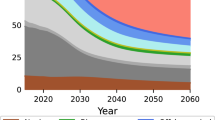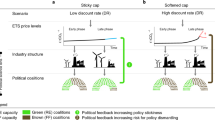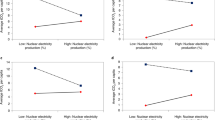Abstract
To support developing countries in greenhouse-gas emission abatement the 2010 Cancún Agreement established various institutions, among others a financial mechanism administered by the Green Climate Fund. However, the instruments for delivering the support and the magnitude of different countries’ financial needs are strongly debated. Both debates are predominantly underpinned by rather aggregate and strongly varying top-down cost estimates. To complement these numbers, we provide a more fine-grained bottom-up approach, comparing the cost of the renewable-energy technologies photovoltaics and wind in six developing countries with those of conventional technologies. Our results unveil large cost variations across specific technology–country combinations and show to what extent fossil-fuel subsidies can negatively affect the competitiveness of renewable-energy technologies. Regarding the instrument debate, our results indicate that to foster transformative changes, nationally appropriate mitigation actions are often more suited than a reformed clean development mechanism. Regarding the debate on financial needs, our results highlight the need for a decision on a fair baseline calculation methodology. To this end, we propose a new methodology that incentivizes changes in the baseline through subsidy phase-out. Finally, we contribute to the debate on domestic versus international support for these measures.
This is a preview of subscription content, access via your institution
Access options
Subscribe to this journal
Receive 12 print issues and online access
$209.00 per year
only $17.42 per issue
Buy this article
- Purchase on Springer Link
- Instant access to full article PDF
Prices may be subject to local taxes which are calculated during checkout




Similar content being viewed by others
References
UNFCCC Kyoto Protocol to the United Nations Framework Convention on Climate Change (United Nations, 1997).
Ellis, J., Winkler, H., Corfee-Morlot, J. & Gagnon-Lebrun, F. CDM: Taking stock and looking forward. Energ. Policy 35, 15–28 (2007).
UNFCCC Benefits of the Clean Development Mechanism 2011 (United Nations Framework Convention on Climate Change, 2011).
Fenhann, J. CDM Pipeline Overview (UNEP Risoe, 2011).
International Energy Agency World Energy Outlook 2010 (International Energy Agency, 2010).
UNFCCC Cancún Agreement (United Nations Framework Convention on Climate Change, 2011).
Haites, E. Climate change finance. Clim. Policy 11, 963–969 (2011).
Olbrisch, S., Haites, E., Savage, M., Dadhich, P. & Shrivastava, M. K. Estimates of incremental investment for and cost of mitigation measures in developing countries. Clim. Policy 11, 970–986 (2011).
UNFCCC United Nations Framework Convention on Climate Change, XXVII.7. (United Nations, 1992).
IPCC Climate Change 2007: Mitigation of Climate Change (eds Metz, B., Davidson, O. R., Bosch, P. R., Dave, R & Meyer, L. A.) (Cambridge Univ. Press, 2007).
IPCC Special Report on Renewable Energy Sources and Climate Change Mitigation (IPCC, 2011).
Van Mielle, T., Höhne, N. & Ward, M. International Climate Financing—from Cancún to a 2°Stabilisation Pathway (Ecofys, 2011).
The IPCC and Greenpeace: Renewable outrage. The Economist (17 June 2011); available at http://www.economist.com/blogs/babbage/2011/06/ipcc-and-greenpeace.
International Energy Angency World Energy Outlook 2009 (International Energy Agency, 2009).
Project Catalyst Meeting the Climate Challenge: Core Elements of an Effective Response to Climate Change (Center for the American Progress, United Nations Foundation, 2009).
Schneider, M., Schmidt, T. S. & Hoffmann, V. H. Performance of renewable energy technologies under the CDM. Clim. Policy 10, 17–37 (2010).
Hoehne, N. Policy: Changing the rules. Nature Clim. Change 1, 31–33 (2011).
Bakker, S., Haug, C., Van Asselt, H., Gupta, J. & Saïdi, R. The future of the CDM: Same same, but differentiated? Clim. Policy 11, 752–767 (2011).
Neuhoff, K. Understanding the roles and interactions of international cooperation on domestic climate policies. Clim. Policy 9, 435–449 (2009).
Castro, P. & Michaelowa, A. The impact of discounting emission credits on the competitiveness of different CDM host countries. Ecol. Econ. 70, 34–42 (2010).
Okubo, Y., Hayashi, D. & Michaelowa, A. NAMA crediting: How to assess offsets from and additionality of policy-based mitigation actions in developing countries. Greenhouse Gas Measurement Manage. 1, 37–46 (2011).
OECD/NEA Projected Costs of Generating Electricity (OECD Publications, 2010).
Peters, M., Schmidt, T. S., Wiederkehr, D. & Schneider, M. Shedding light on solar technologies—a techno-economic assessment and its policy implications. Energ. Policy 39, 6422–6439 (2011).
Castro, P. Does the CDM discourage emission reduction targets in advanced developing countries? Clim. Policy 12, 198–218 (2012).
De Vries, B. J. M., van Vuuren, D. P. & Hoogwijk, M. M. Renewable energy sources: Their global potential for the first-half of the 21st century at a global level: An integrated approach. Energ. Policy 35, 2590–2610 (2007).
Singh, A. Power sector reform in India: Current issues and prospects. Energ. Policy 34, 2480–2490 (2006).
UNFCCC Methodological Tool to Calculate the Emission Factor for an Electricity System (Annex 12, EB 35) (United Nations Framework Convention on Climate Change, 2007).
UNFCCC Draft Revision to the Guidelines on the Assessment of Investment Analysis (United Nations Framework Convention on Climate Change, 2010).
Hekkert, M. P., Suurs, R. A. A., Negro, S. O., Kuhlmann, S. & Smits, R. E. H. M. Functions of innovation systems: A new approach for analysing technological change. Technol. Forecast. Soc. 74, 413–432 (2007).
Battaglini, A., Lilliestam, J., Haas, A. & Patt, A. Development of SuperSmart Grids for a more efficient utilisation of electricity from renewable sources. J. Clean. Prod. 17, 911–918 (2009).
Painuly, J. P. Barriers to renewable energy penetration; a framework for analysis. Renew. Energ. 24, 73–89 (2001).
Mahmoud, M. M. & Ibrik, I. H. Techno-economic feasibility of energy supply of remote villages in Palestine by PV-systems, diesel generators and electric grid. Renew. Sust. Energ. Rev. 10, 128–138 (2006).
Nguyen, K. Q. Alternatives to grid extension for rural electrification: Decentralized renewable energy technologies in Vietnam. Energ. Policy 35, 2579–2589 (2007).
European Energy Exchange AG EEX Emission Rights (EXX, 2011); available at http://www.eex.com/en.
OECD Inventory of Estimated Budgetary Support and Tax Expenditures for Fossil Fuels (Organisation for Economic Co-operation and Development, 2011).
UNEP Reforming Energy Subsidies—Opportunities to Contribute to the Climate Change Agenda (United Nations Environment Programme, 2008).
Michaelowa, A., Stronzik, M., Eckermann, F. & Hunt, A. Transaction costs of the Kyoto mechanisms. Clim. Policy 3, 261–278 (2003).
South Pole Carbon Asset Management Ltd. How To Develop A NAMA By Scaling-Up Ongoing Programmatic CDM Activities On The Road From PoA To NAMAs (KfW Bankengruppe, 2011).
Neuhoff, K. Climate Policy after Copenhagen: The Role of Carbon Pricing (Cambridge Univ. Press, 2011).
Acknowledgements
We want to thank V. H. Hoffmann for providing us with the opportunity to carry out this research. We gratefully acknowledge the support by H. Pacini from KTH Stockholm and J. A. M. Patusco from the Ministério de Minas e Energia, Brazil, for support on Brazilian power-sector data. Further thanks go to G. Gross-Durant for English proofreading.
Author information
Authors and Affiliations
Contributions
M.S. and T.S.S. designed the research. T.S.S. and R.B. developed the model and carried out the data search and the analyses. T.S.S. and M.S. wrote the paper.
Corresponding author
Ethics declarations
Competing interests
The authors declare no competing financial interests.
Supplementary information
Rights and permissions
About this article
Cite this article
Schmidt, T., Born, R. & Schneider, M. Assessing the costs of photovoltaic and wind power in six developing countries. Nature Clim Change 2, 548–553 (2012). https://doi.org/10.1038/nclimate1490
Received:
Accepted:
Published:
Issue Date:
DOI: https://doi.org/10.1038/nclimate1490
This article is cited by
-
Collaborative research and development (R&D) for climate technology transfer and uptake in developing countries: towards a needs driven approach
Climatic Change (2015)
-
Explaining the diffusion of biogas in India: a new functional approach considering national borders and technology transfer
Environmental Economics and Policy Studies (2014)
-
Wind power 'can be cheaper' than photovoltaics, study says
Nature (2012)
-
The fair cost of renewable energy
Nature Climate Change (2012)



